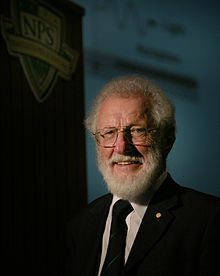Herbert Kroemer
 Herbert Kroemer in 2008 | |
| Born | August 25, 1928 |
| Nationality | Germany United States |
| Alma mater | University of Jena University of Göttingen |
| Known for | Drift-field transistor Double-heterostructure laser |
| Awards | J J Ebers Award (1973) IEEE Medal of Honor[1](2002) |
| Scientific career | |
| Fields | Electrical Engineering, Applied Physics |
| Institutions | Fernmeldetechnisches Zentralamt RCA Laboratories Varian Associates University of Colorado University of California, Santa Barbara |
| Doctoral advisor | Fritz Sauter |
| Doctoral students | William Frensley |
Herbert Kroemer (born August 25, 1928), a professor of electrical and computer engineering at the University of California, Santa Barbara, received his Ph.D. in theoretical physics in 1952 from the University of Göttingen, Germany, with a dissertation on hot electron effects in the then-new transistor, setting the stage for a career in research on the physics of semiconductor devices. In 2000, Kroemer, along with Zhores I. Alferov, was awarded the Nobel Prize in Physics "for developing semiconductor heterostructures used in high-speed- and opto-electronics". The other co-recipient of the Nobel Prize was Jack Kilby for his invention and development of integrated circuits and micro-chips.
He worked in a number of research laboratories in Germany and the United States and taught electrical engineering at the University of Colorado from 1968 to 1976. He joined the UCSB faculty in 1976, focusing its semiconductor research program on the emerging compound semiconductor technology rather than on mainstream silicon technology.
Kroemer was elected as a member of the National Academy of Engineering in 1997 and the National Academy of Sciences in 2003. He always preferred to work on problems that are ahead of mainstream technology. In the 1950s, he invented the drift transistor and was the first to point out that advantages could be gained in various semiconductor devices by incorporating heterojunctions. Most notably, in 1963 he proposed the concept of the double-heterostructure laser, which is now a central concept in the field of semiconductor lasers. Kroemer became an early pioneer in molecular beam epitaxy, concentrating on applying the technology to untried new materials.
Along with Charles Kittel he co-authored the popular textbook Thermal Physics, first published in 1980, and still used today. He is also the author of the textbook Quantum Mechanics for Engineering, Materials Science and Applied Physics.[2]
See also
References
- ^ "Herbert Kroemer". IEEE Global History Network. IEEE. Retrieved 10 August 2011.
- ^ H. Kroemer, Quantum Mechanics, Prentice Hall (1994)
External links
- Not Just Blue Sky
- Nobelprize.org page
- Personal Homepage USCB
- Freeview video Interview with Herbert Kroemer by the Vega Science Trust
- U.S. Patent 5067828 Transferred electron effective mass modulator (Herbert Kroemer)
- U.S. Patent 5013683 Method for growing tilted superlattices (Herbert Kroemer)
- Herb’s Bipolar Transistors IEEE TRANSACTIONS ON ELECTRON DEVICES, VOL. 48, NO. 11, NOVEMBER 2001 PDF
- Influence of Mobility and Lifetime Variations on Drift-Field Effects in Silicon-Junction Devices PDF
- Heterostructure Bipolar Transistors and Integrated Circuits PDF
- 1928 births
- Living people
- Members of the United States National Academy of Sciences
- Engineering educators
- University of Göttingen alumni
- German Nobel laureates
- American Nobel laureates
- German physicists
- IEEE Medal of Honor recipients
- Nobel laureates in Physics
- Semiconductor physicists
- University of California, Santa Barbara faculty
- University of Colorado faculty
- People from Weimar
- German atheists
- Members of the United States National Academy of Engineering
- Alexander von Humboldt Fellows
- University of Jena alumni

